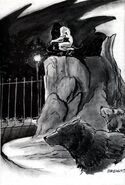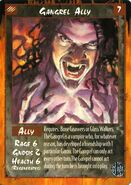
| |
| Name: | Gangrel |
| Plural: | Gangrel |
| Pronunciation: | gang'-grehl |
| Nicknames: | Animals, Bêtes, Outlanders |
| Antediluvian: | Ennoia |
| Faction: | Independent, (formerly Camarilla) |
| Disciplines: | Animalism, Fortitude, Protean |
- gangrel: Middle English, "A vagabond; a drifter." Possibly from gangen, "to go."
The Gangrel are one of the thirteen vampire clans found in the Classic World of Darkness. Nomads who hold closer ties to the wild places than most of their city-bound cousins, they are also closer to the animal aspect of the Beast, and are masters of the Protean Discipline. They were one of the seven founding clans of the Camarilla, but became disillusioned with the sect in the Final Nights, its elders eventually deciding to sever its ties and become an independent clan.
Due to their inherent clan weakness, Gangrel are very close to the Beast within; as they succumb to it, it leaves its mark on their bodies. Every time a Gangrel frenzies, they gain an animalistic feature. This feature is determined by the player and Storyteller; it might be tufted ears, a pelt, a tail, catlike eyes, a snarling voice, tusks, even scales or feathers. Every five such features acquired permanently reduce one of the Gangrel's Social Attributes by one.
History
There are many different approaches to the history of the Gangrel. The disparate nature of the Outlanders and their mostly oral recorded histories make an exact depiction of their early history difficult, but it seems certain that the Gangrel were always wanderers, who followed nomadic tribes around, sleeping in the earth to escape the sun. Although some Gangrel tell the myth of Caine and how Ennoia was cast out due to a betrayal of the Ravnos Antediluvian and forced to live with the beasts, there are many other tales. The Gangrel of Scandinavia tell tales of the Einherjar and Canarl, who was cursed by Odin, while another popular myth was that Ennoia and her twin brother Churka were demigods that warred against each other, Ennoia with the most bravest warriors and Churka with the most cunning, at night, so that the other gods would not learn of their feud. After Ennoia, however, was betrayed by two of her lieutnants who left her, she and her army were driven to the East, where Ennoia left them on their own. By battling Churka's get and the demonic giants that served him, they would do penance for the betrayal of their chieftains. After a long series of battle, the Gangrel were driven into the West, in the civilizations of other Kindred. Other stories tell that Ennoia was the mother of Gypsies and both the werewolves and the Gangrel descend from them. Most among the Clan, however, do not know or care any longer about creation myths of their kind, instead focusing to survive in the present. The mystery remains.
The Gangrel shunned many of the civilizations of antiquity, instead roaming the woods and preying on tribal socities who regarded them as evil spirits that were meant to appease. They had almost nothing to do with the development of the Roman Empire, though occasionally a Brittaniac, Gaulian, or Gothic Gangrel would nose around Rome in the hopes of catching a young neonate off-guard. If there were any Gangrel in the city itself, they were likely attached to any one of the "slave" races - mainland Europeans, Africans, Middle Easterners, or even more exotic peoples. Gangrel fought on both sides of the Punic Wars, although in the end, most flocked to the Ventrue. In Scandinavia, the Methuselah known as Odin, the All-High, held the northmen in a tight grip and ruled as a corporal god, sending them down to raid the civilizations he despised in order for his warriors to earn the right of the Embrace.
Dark Ages
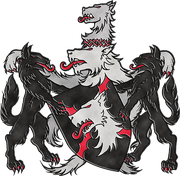
Clan Gangrel in the Dark Ages
The North-Western Gangrel during this period, regarded as members of the Low Clans by their high-blooded peers, were experimenting with expansionism and traveled to the four winds to far off lands to conquer, explore and trade. As paganism was on the decline and many Gangrel could not pose as normal humans due to their growing abnormality, they instead prowled the countryside, feeding from peasants and travelers. During these days, the Gangrel allied themselves with the Tzimisce against the nascent Tremere in the Omen War.
The Islamic Gangrel of the period were called Wah'Sheen, and were essentially straightforward nomads, masters of the deserts and wastelands of Arabia and North Africa. Many Wah'Sheen, even though they followed the teachings of Islam to a point, were also wary of its influence what the encroaching civilization meant to them. A few of the Wah'Sheen felt differently, and eventually split from the main part of the clan, calling themselves the Taifa Gangrel. These were generally more scholarly and adept with civilization than the rest of the bay't.
- VTDA: Veil of Night, p. 132
The Renaissance and the loss of woodland made unlife complicated for the Gangrel. The Masquerade and the heavy decline of pagan religions made hunting difficult for them without drawing notice and the growing anger of the Lupines against human encroachment found more often than not a ventil within a lone Gangrel. Many Gangrel left the Camarilla during this time, instead traveling as Autarkis, leaving Europe completly in search for untouched wilderness or receded into those few tribal societies still existing.
Victorian Age
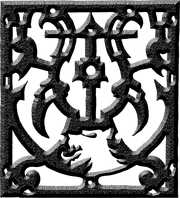
Clan Gangrel in the Victorian Age
In the rapid growth of cities and technology that marked the Victorian Age, very few Gangrel had any interest in staying in towns and hamlets that became industrial centers almost overnight. Additionally, though there were few documented cases of mortals possessing "true faith", the growth of religious influence made many Gangrel cringe, wary of another round of the vicious Inquisitorial practices of the Dark Ages. Only the scholar and theology debator Beckett was known to have any regular dealings with "proper" Kindred society during this period; most other clanmembers hied it to the wilderness to wait out this newest burst of human ingenuity and religious fervor.
Some claim that the City Gangrel began to evolve during this age, due to urbanization and the desolate situation in most fabrics.
Final Nights
Following the Sabbat invasion of the East Coast, the Camarilla suffered another blow with the departure of the Gangrel. The reasons for their withdrawal are unknown; it is rumored then Justicar Xaviar went before the Inner Circle, uttered a single sentence, and left. Word spread through the clan, and over the course of a month the majority of the clan abandoned the sect and became independent.[1][2]
Organization
Status in general among the Gangrel is decided by rites, and these rites involve one of two things: combat or boasting. Combat is usually basic and unarmed; two Gangrel who know each other well may simply spar, but those who are strangers battle until one of the fighters is incapacitated or surrenders. Boasting involves the two Gangrel making larger claims until one Gangrel backs down or asks for proof. The challenged Gangrel must then show proof of their claims or lose the rite and their status.
What little formal organization the Gangrel has is placed around the aptly-named Gather, which are occasional meetings at which local and visiting Gangrel can exchange news, information and stories and decide on local matters. Gathers usually involve notice weeks in advance, as news travels more slowly among the limited network of the Gangrel. Once begun, Gathers usually involve the rites demonstrating status to decide on leadership for the meeting. The rites can take days to accomplish, and must be redone for every Gather, as no two will have the same Gangrel meeting under the same circumstances. Once the hierarchy for the Gather is established, the business at hand can be dealt with. No matter the circumstances, Gathers always break up after a week.
Gathers can also be used to form Revels, which are essentially calls to battle. The Gangrel who participate in a Revel form parties to track down and destroy enemies, such as enemy kindred, Garou, or others who have dared to invade the clan's territory.
There are also meetings called Great Gathers. As a Great Gather relies on a powerful Gangrel who is respected by most of the clan to be called, they are extremely rare. When one is called, any member of the clan who can must travel to the meeting place. There, similar rites of strength and status that are found in a regular Gather take place; however, there are no time limits to either the rites or the Great Gather. Even more rare but related are Grand Revels, which are essentially wars and battles involving the entire clan. Both are considered to be signs of bad luck by most Gangrel, and the fact neither have been called in centuries is seen as a good sign.
Clan Variants
Two bloodlines exist among the Sabbat; the Country Gangrel and the City Gangrel. The Country Gangrel are the same as the main clan, with the Fortitude, Animalism and Protean disciplines. The City Gangrel have adapted to city life, forgoing Animalism and Fortitude for Celerity and Obfuscate. Both are collectively referred to as "Gangrel antitribu."
Country Gangrel

| |
| Founder: | |
| Nicknames: | Hunters |
| Faction: | Sabbat |
| Disciplines: | Animalism, Fortitude, Protean |
The Country Gangrel resemble the independent and Camarilla Gangrel — they are savage, vicious hunters, more comfortable in the wilds between cities than the concrete jungles. The Sabbat has seen a influx of Gangrel converts from the Camarilla, and these Hunters easily lost themselves in stalking and killing.
The Country Gangrel serve the Sabbat as assassins and scouts, using their command of animals to gather intelligence on the comings and goings of other Kindred. They are called Hunters. Travel between cities was never exactly safe, as Lupines seem to prowl any patch of land large enough to grow a few trees (or so Camarilla elders have always told their childer), but with the Hunters prowling about, looking for wayward neonates, itinerant Kindred face even more dire threats.
This might sound like Camarilla propaganda, but the Country Gangrel do all they can to make it true. Free from the constraints of having to look human, these creatures relish the chance to hunt as wolves hunt — savagely and in packs. If they have a regret, it’s that their prey can’t usually run fast enough to make the hunt last.
City Gangrel

| |
| Founder: | |
| Nicknames: | Coyotes |
| Faction: | Sabbat |
| Disciplines: | Celerity, Obfuscate, Protean |
The City Gangrel are a bloodline of the Gangrel that has adapted to urban environments. In the Dark Ages, the bloodline was known as the Greek Gangrel, as they were thought to have originated in Greece. In the modern nights, the City Gangrel form half of the Gangrel antitribu within the Sabbat.
The members of the Sect boasts two Gangrel lines, the City and the Country Gangrel. The City Gangrel remind some Kindred of coyotes — they are creatures well-suited for wilderness life, but they adapt to an urban existence quite smoothly. The high preponderance of prey in the cities, coupled with the Gangrel’s inherent mutability of blood, has allowed the line to flourish. Their association with the Sabbat means that they Embrace prolifically, but also that their unlife expectancy is short.
Unlike Country Gangrel, who can afford to let their animalistic ways take over and their appearances grow truly bestial, the City Gangrel must either adopt a more Nosferatu-like approach to unlife or blend in with their prey. To outward appearance, then, these latter Kindred seem human, dress as appropriate to their area and the social class that they mimic. But City Gangrel are largely Sabbat vampires, and that means they are predators. Any disguise they adopt is strictly that, camouflage to allow them to get close enough to bite.

Gangrel Mariners

| |
| Name: | Gangrel Mariner |
| Plural: | Gangrel Mariners |
| Founder: | |
| Nicknames: | none |
| Faction: | None |
| Disciplines: | Animalism, Fortitude, Protean |
The Gangrel Mariners, called Gangrel aquarii (Gangrel aquarius singular) among Tremere scholars, though the Mariners themselves reject this name, are a minuscule offshot of the main Gangrel clan who make their homes underwater. With the exception of their clan weakness, all apparent features of the bloodline appear to be acquired rather than inborn. This bloodline is not necessarily transfered from sire to childe; the childe of any Gangrel may become a Mariner, and the childe of any Mariner may not necessarily end up as Mariners themselves. A Gangrel's status as a Mariner is determined based upon his affinity to the sea and whether or not that Gangrel chooses to live the majority of his unlife underwater.
Despite the vast reaches of the ocean, the Mariners count only about 30 among their number. Their numbers may be underestimated, as Mariners tend to consider themselves individuals rather than a distinct bloodline, and many older Mariners are often so changed by animalistic adaptions that many — including other Gangrel — mistake them for monsters rather than other vampires.
The Mariners do not have any formal organization as, just like their parent clan, they are largely individualistic. The only known group of Mariners live in a lake in Africa and only consist of four members. Otherwise, if two Mariners ever meet, they will generally determine authority based on age and generation. Mariners also tend to follow two different groups: sedentary and nomadic. The sedentary Mariners will claim a territory, either a specific lake or river or several miles of coastline. These Mariners are extremely territorial and will defend their territory from any intrusions. Nomadic Mariners, on the other hand, have no territory, and will travel wherever the tides carry them.
While Mariners employ Protean, they use a particular version of it. In this version, they gain sonar instead of night-vision and razor-sharp webbed hands and feet instead of claws. Other than that, the only thing that can be considered different about their form of Protean is the animals they turn into with Shape of the Beast, which are always aquatic (though they occassionaly will take the forms of seafaring birds such as an albatross or seagull for their flight form). It doesn't count as a novel Discipline, but rather alternate abilities within the same Discipline. Curiously, although Protean can be learned by any vampire, the Mariner variants can only be learned by other Gangrel.
Greek Gangrel

| |
| Name: | Greek Gangrel |
| Plural: | Greek Gangrel |
| Founder: | |
| Nicknames: | Dogs |
| Faction: | None |
| Disciplines: | Animalism, Obfuscate, Protean |
The Greek Gangrel were an offshoot which began in the Dark Ages. They're the historical antecedents to the modern City Gangrel.
Lhiannan Bloodline
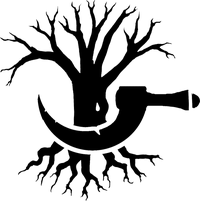
| |
| Name: | Lhiannan |
| Plural: | Lhiannan |
| Pronunciation: | lee-ANN-ann |
| Nicknames: | Druids, Barbarians, Savages |
| Founder: | The Crone |
| Faction: | Independent |
| Disciplines: | Animalism, Ogham, Presence |
The Lhiannan are a territorial, druidic Cainite bloodline who existed in the Dark Ages. Though they are an offshoot of Clan Gangrel, they do not believe they are descended from Caine at all, but instead believe they were created by "the Crone", a mysterious figure who may be the same Crone mentioned in the Book of Nod.
The Lhiannan have a unique connection to the world of spirits, most notably in the form of their Discipline Ogham; this connection gives them an inhuman aura obvious even to humans. They are also bound to the land, unable to leave their chosen woodland territories for long without becoming weak.
Noiad Bloodline

| |
| Name: | Noiad |
| Plural: | Noiad |
| Pronounciation: | |
| Nicknames: | Wanderers |
| Founder: | |
| Faction: | None |
| Disciplines: | Animalism, Auspex, Protean |
The Noiad are a Gangrel bloodline that dwelled in Finland in the Dark Ages. They are depicted as an alien bloodline that may represent the first Cainite presence on the continent of Europe.
Anda Bloodline

| |
| Name: | Anda |
| Plural: | Anda |
| Pronunciation: | an-dah |
| Nicknames: | Tartars |
| Founder: | Dobrul the Brave |
| Faction: | |
| Disciplines: | Animalism, Fortitude, Protean |
The Anda were a bloodline of the Gangrel who existed among the Mongols during the Dark Ages. The bloodline's progenitor was Dobrul the Brave.
They differ from their parent Clan in that they have the compulsion to never rest for a long period of time in a place. Additional, after 10 Frenzies, they gain a Beast Mark.
Ahrimanes

| |
| Name: | Ahrimanes |
| Plural: | Ahrimanes |
| Pronunciation: | AH-ree-maynes |
| Nicknames: | |
| Founder: | Muricia |
| Faction: | Sabbat |
| Disciplines: | (2nd edition) Animalism, Presence, Spiritus |
The Ahrimanes are a rare, all-female bloodline of Kindred from the southern United States who share an unusual bond with spirits. They are an offshoot of the Gangrel antitribu.
Akunanse

| |
| Name: | Akunanse |
| Plural: | Akunanse |
| Pronunciation: | ah-koo-nahn'-say |
| Nicknames: | Weavers |
| Disciplines: | Abombwe, Animalism, Fortitude |
The Akunanse are one of the legacies of Laibon. They take their name and nature from the myths of the "wise spider" of many African folk-tales. They have many features in common with Clan Gangrel, especially their weakness; like the Gangrel, the Akunanse gain animalistic features the longer they live.
Culture
The Gangrel are considered the most feral and predatory of the kindred, and because of their reclusive natures, animalistic tendencies and loose organization, are the least social of the Cainites, preferring solitude to society. They also tend to be extremely territorial and possessive and to enter a Gangrel's territory without permission is certain death. They do have their role and reputation among the kindred as fierce warriors, but to get a Gangrel to agree to work with others, even other Gangrel, can be a difficult, if not impossible, task.
Most of the Clans legends and myths, as well as the ways to garner prestige within the Clan, are done orally. Storytelling and being able to hold a crowd are considered fairly valuable social currency, as there is little else to do in gatherings out in the wilderness besides entertain each another with bravado and song. Most of these stories are true, but a good, satisfying tale is regarded as more important than the facts of the details. Gangrel don't lie, precisely, but embellishing the truth is a good way to sound much more impressive, in the same way a cat puffs up its fur to look more threatening. Keeping to one's spoken word is also highly respected, as when all is said and done, the only thing stopping another vampire from screwing you over is their own sense of honor. This is not to say that the more socially-inclined Gangrel can't learn to play Jyhad. In fact, many enjoy (or at least grudgingly accept) the great masquerade ball of betrayal, conspiracy, and power struggles that define so much of Kindred existence.
The Gangrel also have ties to the Roma, and therefore will protect and shelter them, especially from other Kindred. The Ravnos would also lay claim to the Roma, however, and as a result the two clans have a mutual hatred for each other that goes back centuries.
Given the distinctly rural nature of Clan Gangrel, the observer may be surprised to learn that many higher-generation Gangrel are adept at managing modern technology such as cell phones, computers, and cutting-edge vehicles. Clan Gangrel has realized that knowledge of technology is an important aspect of survival in the modern nights, and even the eldest Gangrel know how to work a microwave.
Embraces
A Gangrel sire often chooses a prospective candidate for the Embrace during feeding. If the mortal prey resists, fighting against what is happening, then his reward after death may be a taste of Gangrel blood. The clan makes many Gangrel this way, dating back to the first warriors selected by Ennoia to fight her war. This method produces a Gangrel with a fierce desire to survive, even if he does not have all the tools. We also find prospective Gangrel through observation. While most mortals remain safely hidden during the night, a few risk the darkness. When one of our clan encounters a mortal like this, they will watch instead of attacking. It takes courage to wander these nights, after all. The Gangrel observes the mortal, watching for any signs of bravery or a knack for survival. Sometimes, a mortal out at night is simply lost - if this proves to be the case, he becomes prey. However, if the mortal shows skill moving about at night, is no coward, and maintains the interest of the observer, he is a good candidate for the Embrace. When we punish, however, there is little effort wasted. A mortal who insults or threatens one of our clan receives a nighttime visit. The Gangrel Embraces the mortal, making the process as painful and terror-filled as possible, and leaves her. Usually the Embrace happens indoors, in the rooms of the person punished, assuring their discovery and destruction. In recent nights, this punishment has fallen into disuse, though there are still some who actively enact it. A choice is almost never offered. This has become a tradition with the clan, since so few of them had a choice. The offspring of these Gangrel are considered by some to be inferior stock, even if they do survive. While not considered outcasts, a Gangrel given a choice rarely receives the same respect of those Embraced traditionally, even after the rites of status. Embracing foes has the potential to backfire on the Gangrel. Should an enemy survive the first nights and develop his power, he could turn his new abilities to hunting the one who cursed him. This is a rare occurrence - part of the punishment is to stack the Odds so that survival is nearly impossible. A new Gangrel who manages to survive has an enviable combination of cunning, raw ability and luck - clearly a dangerous foe to have in pursuit, but possibly one with a bright future in the clan.
The First Nights
After the Embrace, the sire disappears into the night, leaving the new Gangrel on his own. The Gangrel believe that it is better to save the effort of training a childe until after he has proven that he can survive. Thus, the sire completely abandons his new creation in the early nights, leaving him alone to face the struggle of survival. Many do not last beyond even the first night. That first hunger is the strongest, and it brings the Beast quickly to the surface. In the hare of that first wild rage, a childe makes any number of mistakes. If Lupines and mortals don't destroy him, the first sunrise may. If the sire has chosen well, however, the childe quickly grasps his situation and adjusts. The reward for that first night is one of Ennoia's marks. Any Gangrel resilient and capable enough to survive the first few nights soon develops the tools that Gangrel use to survive those that follow. Over time, the childe must learn to grow claws, speak with the animals, and come to terms with our strengths and weaknesses. He must also learn to make decisions on his own, rapidly. The Vampiric condition does not permit long reflection on the proper course to take. Such indecision leads to the Final Death. This is a dangerous time for the childe, lost and without guidance.
Acceptance
A new Gangrel must survive at least one winter before he is worthy of teaching. "How many winters?" is often the first question a Gangrel asks upon first meeting another in the wilderness. A new Gangrel rarely has the correct answer, and thus reveals himself. Tradition has it that any pup so encountered becomes a responsibility. The older Gangrel must aid him in his survival and teach him the ways of the clan, at least until his nature is revealed. If the pup ends up being from the Cainite broods, the Gangrel leaves him to his fate. Once accepted, the new Gangrel learns the stories and traditions of the clan, particularly the greeting ritual and the rites of status. Instruction in the use of the Gangrel gifts follows. The lessons include descriptions of their relationships with the Ravnos, Lupines and Cainites. After months of this teaching, a close bond forms between the student and teacher, similar to the relationship between a sire and childe among the Cainites. After this training, a Gangrel is officially a member of the clan.
Version Differences
(...)
Gallery
References
| Vampire: The Masquerade Clans |
|---|
| Banu Haqim (Assamites) · Brujah · Gangrel · Hecata (Cappadocians, Giovanni) · Lasombra · Malkavian · Ministry (Followers of Set) · Nosferatu · Ravnos · Salubri · Toreador · Tremere · Tzimisce · Ventrue |









